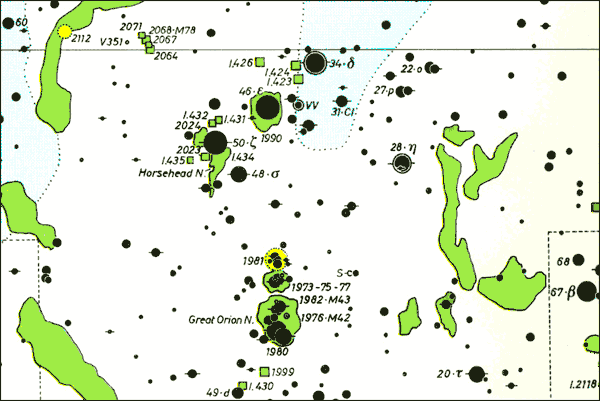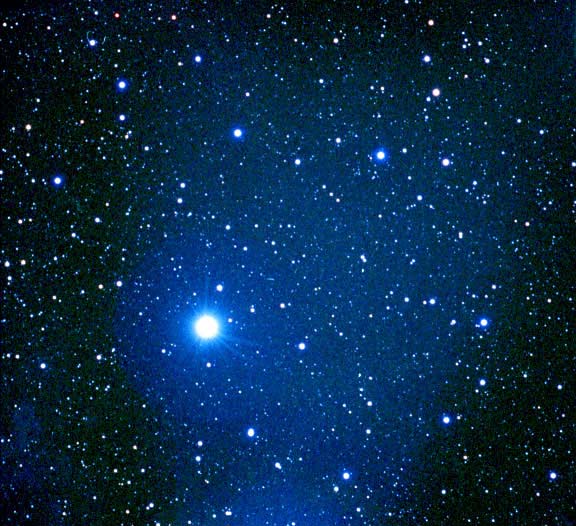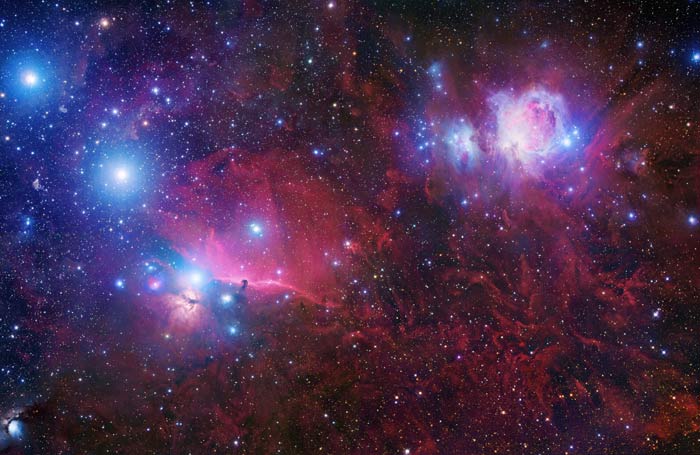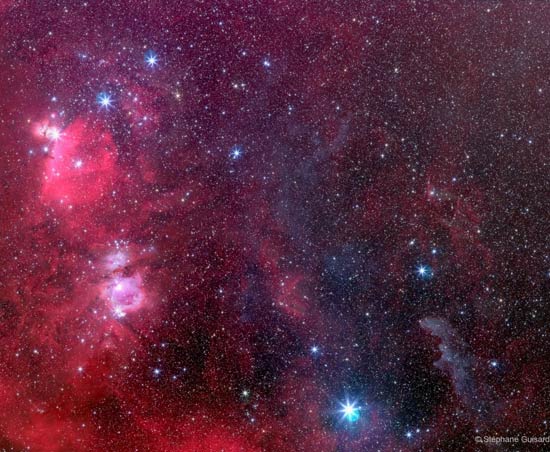

While pursuing the Herschel II observing list, a follow-up program to the more well-known Herschel 400 list, I encountered many a challenging object. Some had very low surface brightness and were difficult to see in the moderately light-polluted skies of southeast Michigan; some were perhaps a clump in a larger structure, like a bright knot in one of a large spiral galaxy’s arms; and some didn’t appear in the charts I was using and I had to go to the Internet to find out where to look. But I ended up tracking them all down—all except one. NGC 1990. Now that I’m done with it, I found it to be more than just a challenge. In fact, I doubt its very existence!
NGC 1990 is cataloged as a diffuse nebula surrounding Epsilon Orionis, also known as Alnilam, the middle star in Orion’s belt. It was discovered by Sir William Herschel in 1786. The New General Catalog (NGC) describes it as “a magnificent or otherwise interesting object, extremely large, extended, Epsilon Ori involved preceding”. It’s listed as being about 50 x 10 arc minutes, though on charts (it appears in Sky Atlas 2000, Uranometria 2000, Millennium Star Atlas, and I’m sure others) it looks to be almost as wide east-west as it is north-south. Here’s a section of chart 11 from Sky Atlas 2000 that shows Orion’s belt and sword region, including NGC 1990:

(chart copyright Sky Publishing Corp., used with permission)
Sounds simple enough, from the description it ought to be a piece of cake. But speaking for myself, it has proven to be anything but!
I’ve attempted to observe this nebula on several occasions, from Peach Mountain to the darker skies of Cherry Springs State Park to the pristine skies at the Okie-Tex star party. I’ve looked for it in everything from my 13.1-inch Dob to an 80mm TMB refractor. I’ve tried various light-pollution reducing filters. I’ve tried direct vision and averted vision. I’ve tried moving the star outside the field of view and letting the field drift by. Nothing. In no case could I ever conclude that there was anything there. Alnilam is 2nd magnitude, so there will be glare surrounding it regardless of what telescope you are using, and I cannot convince myself that I’m seeing anything other than that glare.
I am not alone in my skepticism. NGC 1990 is conspicuously absent from noted visual observer Steve Gottleib’s observations, which is suspicious in itself. See http://ngcic.org/gottlieb/default.htm. In the NGC-IC Project (www.ngcic.org) you’ll find the following quote from Dr. Harold G. Corwin, Jr.: “In spite of this nebulosity having been “seen” by WH, JH, [ William and John Herschel, respectively] and Dreyer, as well as by several amateurs in recent years, there is no trace of nebulosity on any photograph of the area. JH suggested that the nebulosity extends at least 12 arcmin north and south of Epsilon Orionis, while Dreyer makes it more extensive to the south. (On the POSS1 red plate, the star is apparently close to the center of an extended, striated nebulosity. This, however, is not visible on any other photo, including several color photos that would certainly show a red nebulosity if it existed. This striation is a defect on the red plate, apparently caused by imperfections or reflections in the red Plexiglass filter.) It is just possible that this may be another case like IC 349 (which see) which is so close to Merope as to be not easily imaged. Until Eps Ori is imaged in such a way that the star can be removed to show the nebulosity that the Herschels and Dreyer saw, we have no choice but to call NGC 1990 an illusion.”
Experienced observers being fooled into seeing something that is not there is not without precedent. Charles Messier saw nebulosity around M40, which has been proven to be simply a double star. And consider this note by Steve Gottlieb: (http://observers.org/tac.mailing.list/2005/Sep/0143.html): “Consider the case of NGC 4530. On no less than four separate nights, John Herschel recorded a “nebulous atmosphere” about 3’ diameter about this 4th magnitude star. There’s no trace of nebulosity on any images around the star though. Dew on his eyepiece? Very poor seeing? Expecting to see something that just wasn’t there? Whatever the reason, here was a very experienced observer being fooled.” There are other examples easily found on the Internet should you care to look.
There is some evidence supporting its existence, though. If you do a Google search for images of NGC 1990 you’ll come across several instances of this image, one of which being found at http://upload.wikimedia.org/wikipedia/commons/8/8a/Ngc1990.jpg:

(image copyright Glen Youman, http://astrophotos.net/, used with permission)
I’ve matched it against charts of the Alnilam region and it indeed is the right area. It shows some faint, blue, reflection nebulosity. But from what I’ve seen this is the only image of Alnilam that shows any nebulosity there. Virtually every other image I’ve found shows nothing other than glare around the star.
Youman’s image notwithstanding, the image below is the first of two that clinch the non-existence of NGC 1990 for me. It can be found at http://apod.nasa.gov/apod/image/0701/oriondeepwide_gendler_f.jpg:

(image copyright Robert Gendler, http://www.robgendlerastropics.com/, used with permission)
The above image goes deeper into the nebulosity surrounding this area than just about any other I have seen. Once you get over the splendor of it, take a close look at the middle star of Orion’s belt (at just above center on the left). Compare it against Delta Orionis, the belt star to Epsilon’s upper left. They look pretty much the same don’t they? In fact there’s a blue glow surrounding all of the bright stars in the image. But isn’t there more around Epsilon compared to Delta? They’re both second magnitude stars, right? Not so fast my friend! Epsilon is magnitude 1.7, while Delta is only magnitude 2.4. You would expect to see a little more glare around Epsilon, and you do. I don’t see anything in this image that would indicate that there is nebulosity surrounding Alnilam. There is some reflection nebulosity to the west of Epsilon (just above it in this image) and it is considerably fainter than the elusive IC 434, the emission nebula against which the Horsehead Nebula is silhouetted. If NGC 1990 is truly there, then it must be even fainter than that, making Youman’s image a truly remarkable achievement.
Here’s another image of the area I found that goes even deeper into the nebulosity permeating Orion. You can find this image at http://antwrp.gsfc.nasa.gov/apod/image/0804/orionwitch_guisard_big.jpg:

(image copyright Stephane Guisard, http://www.astrosurf.com/sguisard/, used with permission)
Again, there is nothing unusual surrounding Epsilon. Compare that region with the Witch Head nebula seen at lower right of the image. If NGC 1990 truly exists then it must be many magnitudes fainter than even the Witch Head.
So is there really a nebula there? Given the small amount of evidence to support the existence of NCG 1990, and the wealth of evidence against it, my conclusion is that it is indeed simply an illusion. Visual observers who claim to see it are simply mistaking glare from the bright Alnilam for a nebula. Psychologically they “know” that there is a nebula there, so they see one. In other words, they are using averted imagination! Even if it really does exist, then it must be extremely faint, and in my opinion out of the reach of even the largest of amateur-sized telescopes, at least visually. That’s my story and I’m sticking to it!
So, I leave you with is this question: NGC 1990—fact or fiction? We are entering prime Orion observing season, cloudy skies and bone-chilling temperatures notwithstanding. Next time you are out with your scope, take a close gander at the middle star of his belt. I’d like to know—what do you see?